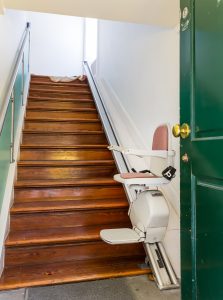It is likely that you have read articles or heard discussions about stress incontinence, urge incontinence and overflow incontinence. However, functional incontinence is a common condition that is less well known.
What is Functional Incontinence?
Functional incontinence is also known as transient incontinence. This condition occurs when a person cannot reach a toilet in time due to a physical or mental impairment. A person with functional incontinence often has no stress or urge symptoms or a high postvoid residual but is incontinent as he or she cannot reach the bathroom. Just like other types of incontinence, dealing with Functional Incontinence can affect a person’s emotional, psychological and social life.
Functional Incontinence caused by a Cognitive Impairment
Although many of us think of finding a bathroom as a simple task, this can seem daunting to someone who has a cognitive impairment. A person with Alzheimer’s disease or other forms of Dementia, for example, may not think clearly enough to plan trips to the restroom or find the
restroom. It is in the final stage of Alzheimer’s that a person will experience a loss of control over their movements, including their bowel and bladder muscles. However, few people with Alzheimer’s may become incontinent during the middle stages of the condition. Anna Murtough shared her story of taking care of her Dad with Dementia on the Alzheimers.org.uk website. She explains, “unless you have been personally impacted by it, I find people don’t fully understand what it’s like to love and care for someone living with Dementia”. Anna explains, “he needed 24-hour care, became doubly incontinent, and as consequence, my mother’s health was deteriorating”. She pleads “I wish more people in society would recognise that our elders with incontinence need as much care a love as do our youngsters, especially when they are blighted with a devastating brain disease”.
Another mental condition that can cause functional incontinence is severe depression. People with very severe depression, particularly seniors, may lose all desire to care for themselves. This can even include using the restroom and responding to the need to urinate. This condition is made much worse if the individual already has another cognitive impairment. In Functional Incontinence, a person with depression will usually be aware of the need to urinate however lack the motivation to care for themselves.

Functional Incontinence Caused by a Physical Impairment
Common physical causes of functional incontinence are musculoskeletal problems such as back pain, Arthritis, or neurological problems such as Parkinson’s disease or Multiple Sclerosis. Further worsening the problem, public restroom facilities are not always easy to get to or are often not catered for people with disabilities. Medical conditions which can cause you to become wheelchair bound include Cerebral Palsy, Heart Failure and Osteoporosis. Other common physical causes of Functional Incontinence include the following:
- Poor Eyesight
- Paralysis
- Poor Dexterity
- Weak bones and muscles
- Falls and Accidents
What are the methods of treating Functional Incontinence?
In making the diagnosis of Functional Incontinence, a Doctor or GP will first have to rule out any other potential causes of incontinence. Treating functional incontinence requires analysing an individual’s physical health, cognitive health and the environment they live in. Treatment aims to improve the patient’s functional status, modifying transient causes for the incontinence, and reducing environmental barriers to toileting or providing sufficient toileting assistance to avoid incontinence episodes. A professional will provide a physical examination, including the abdomen, genital, rectal and neurologic screening and mobility/joint examination.
If you have functional incontinence or are caring for someone with the condition, the experience can be tiring and cause a great amount of stress. By taking into account physical and mental health and environmental factors, however, you can be a step ahead in making the condition easier to live with.
In addition to seeing a professional, you should consider the following questions:
-
Is the Toilet Access Clear?
The first thing you can do when trying to manage the condition is to make sure your bathroom is accessible and the route from your bathroom has no clutter or hazards for falling over. If you are in a wheelchair, it is especially important to ensure the ground is clear and that you can reach the toilet with ease. A stairlift is a useful addition to many people’s homes providing easy access to upstairs when it becomes difficult to climb the stairs quickly when reaching a toilet. These products feature a motorised seat which runs up and down a staircase on a rail or track. They are often powered by electricity and have a control on the stairlift which you can press to operate. Although you may be able to walk, they are ideal if you use a walking aid to do so. Keeping your bathroom uncluttered can help avoid any delay in getting there.

Indoor Stairlift
-
Is your Clothing delaying your quick run to the Toilet?
Ensure you are not wearing clothes that require others to help you remove. If you are by yourself or you live alone, you need to be proactive and wear clothes that are simple to remove. You can purchase open back clothes, drop down trousers and more to make this experience easier. Side zips with easy to grab pull tags and soft pop-fasteners are ideal for seniors in a wheelchair. If you are disabled, elderly, have limited mobility or restricted arm or leg movement, adaptive clothes will make a huge difference. Trousers with an elasticated waist are often easier to remove than zips.

-
Do you have sufficient toileting assistance?
People with cognitive or physical impairments can experience difficulties with using the toilet. For individuals with Dementia, using contrasting colours, for example, a black seat on a white base, can be helpful. A sign on the door with words and a picture will also help them to remember which room the toilet is. You could purchase movement sensor lights in the bathroom to help a person at night time. Equipment such as handrails and a raised toilet seat may help if you or someone you are caring for has problems with slipping off the toilet or falling. A commode chair may be useful if reaching the toilet becomes completely impossible.
If you have trouble transferring from a wheelchair to toilet, try to have someone with you who can help. Often, simple behavioural treatments that help other forms of incontinence can be helpful in reducing accidents caused by functional incontinence. These treatments include bladder training, pelvic muscle exercises and timed voiding. Finally, if the causes of your Functional Incontinence can be treated, it is important to reach out to a Doctor and ask the people around you about the methods of surgery that are available for you. For a problem with mental health, do not ignore it and let it alter your life. Look for a GP or mental health professional in your area who can provide you with guidance.
If you are taking care of a senior who has Functional Incontinence, it may be helpful to find private social media groups and websites where you talk to others in a similar situation. As young Carer, Anna, explains, “something I have gained a lot of strength from is hearing about others who are in a similar situation, through groups where other carers like me can vent their stories and seek advice”. Functional incontinence is not an easy condition to live with, however, you should not give up on looking for suitable treatment.

Originally posted 2018-01-23 16:56:21.











Leave a Reply